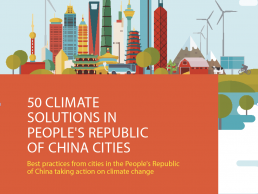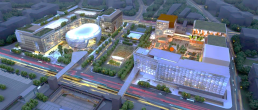First appeared in

Asian Development Bank
50 climate solutions from cities in the People's Republic of China
Shanghai is setting the bar for sustainable design with a new 379,000 m2 low-carbon business development, showcasing innovative engineering and sustainability features that reduce the facility’s carbon footprint.
Hongqiao Tiandi, known as “The Hub” is Shanghai’s first low-carbon business development. The whole site is designed to use energy efficiently and from renewable resources, for example by matching the varied demand for heat and cooling across the development through a smart, integrated network. More than 50% of the whole development has been awarded a 3-star China Green Building Label, and the facility has achieved an average energy saving ratio of over 70%.
70%
AVERAGE ENERGY SAVINGS FOR EACH BUILDING IN ‘THE HUB’.
In addition to the energy-saving measures, water harvesting and recycling systems provide more than 40% of the water demand, recovering stormwater and condensate from air conditioning. The design also includes natural ventilation, recycled construction materials, maximized utilization of daylight and high-efficiency lighting systems. By removing traditional ventilation units, roof space is freed up for social and green space. Since opening in 2015, the facility has attracted sustainable businesses from around Shanghai to get a glimpse into the future of green design.

Opened in December 2015, The Hub illustrates how low-carbon business districts can be both energy efficient and pleasant for the occupants.
The Challenge
Buildings in the PRC use 25% of the nation’s energy supply and produce 30% of the greenhouse gas emissions. In order to meet the PRC’s ambitious emissions reduction goals, buildings will need to be designed in a smarter way to reduce the consumption of energy and water. In Shanghai, ‘The Hub’ is piloting new sustainable design principles for the future.
Co-Benefits
Environmental This office development’s innovative design features contain energy-saving measures, water recycling systems and the integration of recycled materials, contributing to the reduction of carbon emissions and water use in Shanghai’s central business district.
Health The incorporation of natural ventilation, daylight, thermal comfort control systems and quality lighting improves comfort and indoor air quality benefits the building occupants.
Social Green, outdoor spaces are integrated into the design, creating new social spaces for workers and residents alike.

